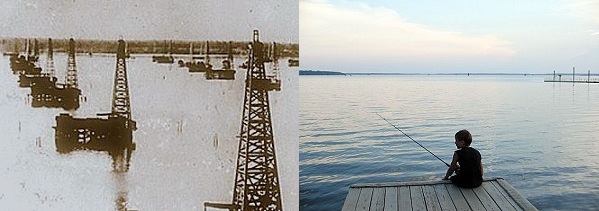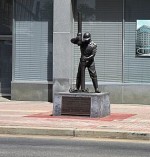The first Louisiana oil well revealed the Jennings oilfield in 1901 – just nine months after the historic “Lucas Gusher” at Spindletop Hill in nearby Beaumont, Texas. The discovery launched the Pelican State’s petroleum industry. Read more in First Louisiana Oil Well.
Louisiana’s young petroleum businesses boomed in the early 1920s, energized by discoveries of the Monroe natural gas field in 1916, the Homer oilfield in 1919, and Haynesville gas field in 1921.
With abundant investment opportunities – thanks in part to the public’s fascination with “black gold” – oil companies drilled wells to meet growing demand for gasoline. But high exploration and production costs, transportation, refinery hazards and price fluctuations created an unforgiving business environment, then as now.
Many kinds of petroleum companies would fail during Louisiana’s first boom, taking with them the hope for riches by unwary investors. Although many people tried to profit from the first Louisiana petroleum boom, many companies failed.
Established by two well-experienced independent producers, International Oil & Gas Corporation began operations in 1919 with oil production from the Pine Island oilfield. Founders H.B. Staver and P.L. Hart had operated in partnership since 1912 working the Mid-Continent oilfields.
International Oil & Gas’ acquisition of the Pine Island Refining Company’s refinery at Cedar Grove prompted stock sales promotions as far away as Washington, D.C.

In 1911 Gulf Refining Company built drilling platforms to reach the oil beneath Caddo Lake in Louisiana. This early “offshore” technology worked well and production continues today out of sight of most young fishermen.
“HERE’S YOUR BIG OPPORTUNITY” declared an ad in the February 29, 1920, Washington Post. Stock was offered at $1.50 a share. International Oil & Gas was reported to hold 50,000 acres under lease, “scattered through Louisiana, Arkansas and Texas.” The same advertisement noted at its bottom, “Acceptable Stocks and Bonds taken in Exchange.”
At the same time a sceptical Magazine of Wall Street dedicated several paragraphs to International Oil & Gas under the headline, “Securities We Would Not Recommend and Why.”
Not withstanding Wall Street cautions, the January 1921 trade journal the Petroleum Age reported a $500,000 refinery upgrade was nearing completion and would increase capacity to 1,000 barrels a day of “high grade motor oils, red engine oils, pale oils, gas oil, road and lube oils.”
Another industry publication, Oildom, reported the upgrade to cost only $250,000. In any case, the refinery was soon idle and remained so until April 1922.
About this time – and in an effort to satisfy growing debt – International Oil & Gas leased its refinery to Louisiana Oil & Refining Corporation. Despite the effort, International Oil & Gas defaulted on its bond debt. The once promising company became an acquisition target for predators like Lewis Oil Corporation.
Lewis Oil Corporation
Lewis Oil had been organized by Sheridan C. (S.C.) Lewis, a Dallas lawyer, in March 1921. Just two years later, Lewis’ company represented itself as a major oilfield operator with production, refining and sales of petroleum products resulting in net assets of more than $6.6 million.
By November 1923, Lewis Oil had managed to acquire International Oil & Gas (share owners would have been obliged to redeem their obsolete certificates for struggling Lewis Oil shares). Two years later, the president of Lewis Oil faced a federal indictment on charges of stock manipulation.
Not interested in legitimate petroleum exploration, S.C. Lewis’ Lewis Oil was a shell company he used to take over distressed companies. He had oversold the company’s bond issue by almost 70 percent and printed $100,000 worth of unauthorized notes for himself, according to the 1994 book The Great Los Angeles Swindle by Jules Tygiel.
Lewis Oil Corporation’s acquisitions included Julian Petroleum Corporation for $500,000 from C.C. (Courtney Chauncey) Julian – who faced federal charges for similar stock manipulations.
Even as the pre-“blue sky law” era’s wheels of justice turned, Julian Petroleum and Lewis Oil over-issued stock, creating an elaborate Ponzi scheme to swindle investors out of millions.
By 1927, Lewis Oil was deep into litigation that ultimately led to indictments, convictions and prison sentences for president S.C. Lewis among others. Lewis got out of prison on February 24, 1935, about a year after C.C. Julian committed suicide.
As one publication reported: “Penniless at death and a fugitive from justice in the United States, C.C Julian, one-time millionaire oil operator of Oklahoma and California who took poison early today in a fashionable Shanghai hotel, is to be buried by his friends.”
American Oil Refinery

A roughneck statue in Shreveport commemorates an 1870 well that provided the first commercial use of natural gas in Louisiana.
By 1918, annual production from the Caddo-Pine Island oilfield reached 11 million barrels.
American Oil Refinery organized in Shreveport with only $15,000 capital and the intention to build a small refinery at nearby Cedar Grove, a town recently added to the Kansas City Southern Railroad, according to the February 1916 Fuel Oil Journal.
By 1918, the oil company acquired the holdings of three struggling exploration ventures – Jim Clark Oil Company, Income Oil Company and Greer Oil Company. For two years, American Oil Refinery tried to build its 150-barrel a day lubricating refinery to increased capacity and profitability. It apparently didn’t work out.
In May 1918 two Shreveport businessmen, R.L. Spann and the former superintendent of the nearby Caddo Oil & Refining Company, E.C. Christman took over the company. In June they renamed it the Pine Island Refining Company after recapitalizing at $50,000, according to the Oil Trade Journal. Two years later, the company failed. Its 150-barrel a day refinery at Cedar Grove was purchased by International Oil & Gas Corporation.
Since Louisiana’s first commercial oil well in 1905, more than 224,000 wells have been drilled in 61 parishes. The state’s first commercial natural gas was discovered in Shreveport in 1870 while drilling for water for an ice factory. Read more in Louisiana Oil City Museum.
___________________________________________________________________________________
The stories of exploration and production companies joining petroleum booms (and avoiding busts) can be found updated in Is my Old Oil Stock worth Anything? The American Oil & Gas Historical Society preserves U.S. petroleum history. Please support this AOGHS.ORG energy education website. For membership information, contact bawells@aoghs.org. © 2018 Bruce A. Wells.
___________________________________________________________________________________

